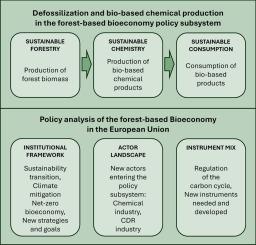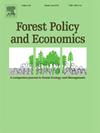Forest-based bioeconomy and bio-based chemical production in the European Union: Policy issues, institutions, actors, and instruments in a changing forest policy subsystem
IF 3.8
2区 农林科学
Q1 ECONOMICS
引用次数: 0
Abstract
The chemical industry is one of the largest consumers of fossil raw materials in the European Union (EU). Phasing out the use of fossil carbon both for energetic and material use (decarbonization/defossilization) requires the introduction of alternative processes and systems of production and consumption. One strategy that brings forward the defossilization of the chemistry sector is the use of biomass (bio-based carbon) as a raw material to produce bio-based chemical products. Our analysis focuses on the intersection of the forest-based bioeconomy, bio-based chemical production, and consumer preferences. It points out how the sustainability transition of the chemical industry changes the forest-based bioeconomy policy subsystem in the EU. Drawing on the Political Process inherent Dynamics Approach (PIDA), we apply a mixed-methods research design that integrates three scientific perspectives in an interdisciplinary approach. We illustrate how shifts in forestry, the chemical industry, and consumer preferences change the forest-based bioeconomy policy subsystem. Numerous strategies and goals referring to international agreements have been introduced by the EU in recent years and new actors from the chemical industry are entering the policy subsystem. Yet, new instruments are needed and developed for the regulation of the carbon cycle and negative emissions. The study provides directions for research on the defossilization of the chemical industry through the use of forest biomass and points out potential conflicts and trade-offs in production, consumption, and regulation.

欧洲联盟的森林生物经济和生物化学生产:变化中的森林政策子系统中的政策问题、机构、行动者和工具
化工行业是欧盟(EU)最大的化石原料消费者之一。要逐步停止将化石碳用于能源和材料用途(脱碳/去化石化),就需要采用生产和消费的替代过程和系统。提出化学部门去化石化的一个策略是使用生物质(生物基碳)作为原料生产生物基化学产品。我们的分析集中在森林生物经济、生物化学生产和消费者偏好的交集上。指出了化学工业的可持续性转型如何改变欧盟森林生物经济政策子系统。借鉴政治过程内在动力学方法(PIDA),我们采用混合方法的研究设计,在跨学科的方法中整合了三种科学观点。我们说明了林业、化学工业和消费者偏好的变化如何改变以森林为基础的生物经济政策子系统。近年来,欧盟根据国际协议提出了许多战略和目标,化学工业的新参与者正在进入政策子系统。然而,需要和开发新的工具来调节碳循环和负排放。本研究为利用森林生物质实现化学工业的去化石化提供了研究方向,并指出了在生产、消费和监管方面可能存在的冲突和权衡。
本文章由计算机程序翻译,如有差异,请以英文原文为准。
求助全文
约1分钟内获得全文
求助全文
来源期刊

Forest Policy and Economics
农林科学-林学
CiteScore
9.00
自引率
7.50%
发文量
148
审稿时长
21.9 weeks
期刊介绍:
Forest Policy and Economics is a leading scientific journal that publishes peer-reviewed policy and economics research relating to forests, forested landscapes, forest-related industries, and other forest-relevant land uses. It also welcomes contributions from other social sciences and humanities perspectives that make clear theoretical, conceptual and methodological contributions to the existing state-of-the-art literature on forests and related land use systems. These disciplines include, but are not limited to, sociology, anthropology, human geography, history, jurisprudence, planning, development studies, and psychology research on forests. Forest Policy and Economics is global in scope and publishes multiple article types of high scientific standard. Acceptance for publication is subject to a double-blind peer-review process.
 求助内容:
求助内容: 应助结果提醒方式:
应助结果提醒方式:


